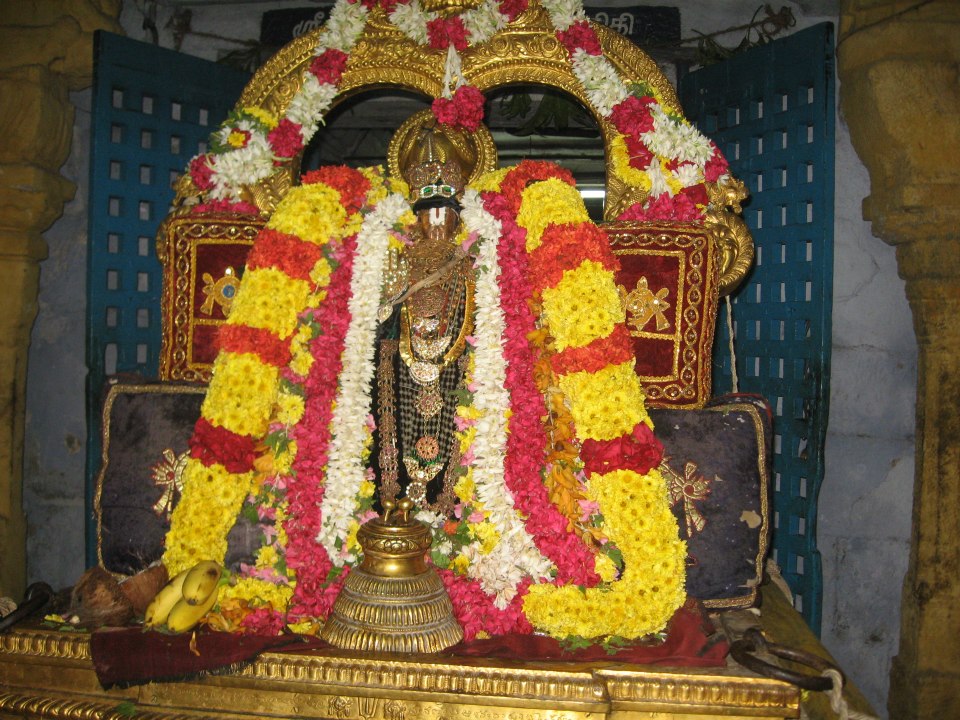SrI:

Mundakopanishad-12
By U. Ve. , MahAmahOpAdhyaya, Dr. Sriman Srirangam Nallan Chakravarthy Raghunathacharya Swami: Translated into English by Sriman K.S. Rajaji I.A.S.,
we continue with the Mundakopanishad, the treatise by S’ruthaprakAsíkAchArya as – as to how the Brahman only, qualified by the sentient and insentient, can justify the meaning of the words eka vijnAnena in the s’ruthi vAkya.
Summary: One should consider the qualified Brahman in the s’ruthi vAkya “Eka vijnAnena sarva vijnAnam” for the word “eka”. He should not consider only the swarUpa –the nature, of the Brahman. It is very clear that in such an instant, it not possible to have the knowledge of the attributes – the vis’eshaNas from the knowledge of the subject Brahman – the vis’eshya. With the knowledge of the qualified entity, qualified by its attributes, it is possible to know completely, the constituents of the entity viz., the attributes as well as the qualified entity – the vis’eshaNa and vis’eshya respectively. However, when you consider the ‘lump of clay and the pot’ illustration, it shows the svarUpaikyam – the unity in nature and characteristics of the causal material – the upAdAna, and the effect – the kArya. But the same svarUpaikyam cannot be told for the combination of the universe comprising the sentient and insentient; and the Brahman. It goes against all the Veda VAkyas. Considering the sensibilities and insensibilities; controlling and controlled or ruling and being ruled nature; ignorance and omniscience etc., of the sentient and insentient respectively there is a vast difference between the nature of the Brahman – the Isvara and the sentient and insentient – the chit and achit according to all the Vedas and scriptures, there cannot be any svarUpaikyam – the identity or unity of the nature between them. The inner controlling characteristic – antharyAmithvam of Brahman is evident from the s’ruthi VAkyas like “thadanupravis’ya”, “sathcha thyachchAbhavath”, “aithadAthmyam idam sarvam” etc. From that characteristic of the Brahman, vis’ishTaikyam – the qualified oneness (by nature) is confirmed by the vEdas. Even during the dissolution of the universe, the qualified oneness only is authentic for the Brahman, who becomes one with the subtle form of the dumb or insensible cosmic matter. The meaning of the word ekibhAva in the s’ruthi vAkya thamah pare deve ekeebhavathi is noteworthy. According to abhootha thadbhAve chvih – a specific rule of Sanskrit grammar, (anekam ekamiva sampadyamAnam – many entities (put together) looking as though all of them became a single entity), the subtle cosmic matter joins the Brahman to appear as if it has become one with the Brahman. In other words, the preposition or suffix – chvi makes it clear that the word ekeebhAva gets the meaning of “appearing as though it is a single entity, when all the entities are held together by a unique inseparable bond.” Thus, it has been established that from the knowledge of the Brahman, who is having an authenticated qualified oneness for all the time, it is possible to get to know about the universe, which has an inseparable relationship with Him and is an attribute of Him.
An objection:
According to the Srivaishnava siddhAntha, all the entities viz., the world of SriVaikuntam; the buildings, towers etc. there; the resident nithya sUris etc., are all eternal. Isn’t it so? For all these entities, definitely the Brahman is not the material cause. Hence, by the knowledge of Brahman – the material cause, it may be possible to know about the physical universe – a product of the cosmic matter, but how can one know about the eternal entities like the SriVaikuntam etc.? If that is not known, how can the statement eka vijnAnena sarva vijnAnam be true?
The answer:
My dear sir, please take note of the words idam sarvam in the mantra presently being discussed – “kasminnu bhagavo vijnAthe idam sarvam vijnAtham bhavathi?” These words are clearly pointing out the visible universe – idam sarvam – this everything, only. It does not speak about the eternal universe – the SriVaikuntam, which has been confirmed as eternal by the scriptural statements like “thripAdasyAmritham divi” etc. Hence, it is immaterial whether those eternal entities are known, or not. The substance of the statement sarvam idam vijnAtham – all this is known, is – that after having knowledge about that material cause, it is possible to have the knowledge about the entire universe that has been derived from that material cause.
Another objection:
The S’ruthis are emphatically denying presence of any other entity, in the beginning, other than the One, by the statement – “sadeva Somya idamagra Aseeth, ekameva, advitheeyam – O Somya, in the beginning there was sath alone, one only and there was no second entity”. It says that there is no second entity at all. In such circumstances, stating that the SriVaikuntam, its residents, mansions there etc. are eternally present, is definitely contradictory to the oneness professed above. Is it not?
To be continued
In our next posting, we shall see how this objection was answered and some more objections and their answers.
Courtesy — Srinivasa Ramanuja DAsan.








